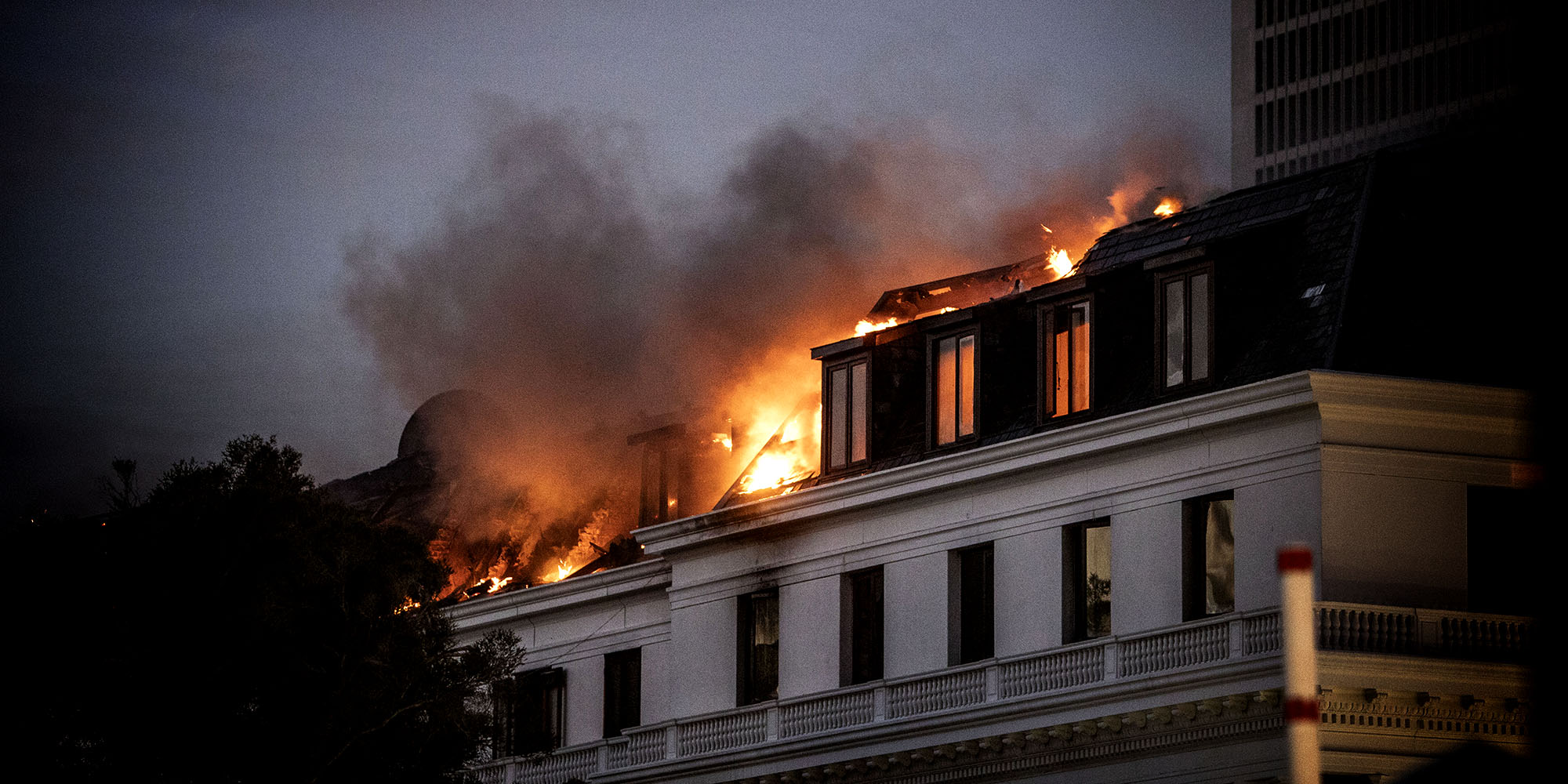The flames and smoke billowing from the National Assembly on 2 January 2022 were seen across the Cape Town City Bowl, and the sirens of fire engines and other emergency services cut through the Sunday quiet.
As Daily Maverick reported at the time, the Parliamentary Protection Services (PPS) had not been on duty. They had been withdrawn from working nights and over weekends and public holidays during the festive season.
 Firefighters battle the blaze engulfing the National Assembly in Parliament on Monday, 3 January 2022. (Photo: Leila Dougan)
Firefighters battle the blaze engulfing the National Assembly in Parliament on Monday, 3 January 2022. (Photo: Leila Dougan)
Withdrawing the in-house parliamentary protection is the outcome of leaving the PPS without permanent bosses since July 2015 when Zelda Holtzman and Motlatsi Mokgalta were suspended in ructions in the parliamentary administration – and demoting the Parliamentary Protection Services from a stand-alone division into a unit in household services.
On Wednesday, Secretary to Parliament, Xolile George, responding to a direct question, said, “Do we think Parliament would still be existing and standing... had there been staff of Parliament not on forced leave? The answer is, yes.”
The absence of the PPS “did contribute significantly to the vulnerability of Parliament”, he added.
As the national legislature had been left to be protected by the SA Police Service, slip-ups like sleeping on duty fell to them. Or, as the report summary released put it: “Lapses in perimeter monitoring were identified, including an incident where a SAPS officer tasked with monitoring a motion-detection camera had been asleep when an intruder breached the fence. The investigation raised questions regarding SAPS patrols during that period…”
But the summary of the report by an unnamed independent forensic investigator raises questions – details remain unknown and uncheckable.
“On legal advice, the report will not be released,” said George.
Five parliamentary officials have been identified, but left unnamed, as having to answer on the security front for the fire at Parliament. However, it’s public record that the memo withdrawing the PPS over the festive season was signed in December 2021 by then-acting Secretary to Parliament, Baby Tyawa, now retired.
 Firefighters battle the blaze that engulfed the National Assembly at Parliament on Monday, 3 January 2022. (Photo: Leila Dougan)
Firefighters battle the blaze that engulfed the National Assembly at Parliament on Monday, 3 January 2022. (Photo: Leila Dougan)
Not naming anyone at this stage was important for their privacy and fairness in the unfolding internal proceedings, was about as much as George was prepared to say.
Other engagements are also unfolding regarding findings relating to the SAPS and the Department of Public Works, which is responsible for the upkeep of state buildings.
On Wednesday, it remained unclear if the SAPS had updated Parliament on the “departmental investigations” against four police officials over the fire, as SAPS management told MPs on 21 January 2022.
They remained unnamed but were identified as the Protection and Security Service relief commander, two police officials on duty to monitor CCTV on the police surveillance system, and one working the parliamentary camera monitors.
The SAPS presentation described the events of 2 January 2022: “Members of the PSS (Protection and Security Services) noticed smoke coming from the National Assembly area. Upon investigation and questioning the suspect... Zandile Christmas Mafe was arrested for trespassing.”
The trial of Mafe, against whom the State added charges of treason, continues to play out in the Western Cape High Court, including psychological evaluations that found him unfit to stand trial.
Read more in Daily Maverick: Alleged Parliament arsonist Zandile Mafe rejects psychiatric panel findings that he is not fit to stand trial
At Parliament, the SAPS effectively leveraged the fire to step up the taking over of security with a so-called implementation plan on the back of the hamstrung PPS. This included ad hoc fencing, rolls of razor wire and police vehicles parked at all gates, now closed and padlocked. It took the City of Cape Town months to secure the reopening of the Company’s Garden gate and its walkway, an important green lung in the city centre to the rear of Parliament.
The SAPS was approached for comment on the report summary but had not responded by publication.
 Smoke from Parliament over central Cape Town on 3 January 2022. (Photo: Leila Dougan)
Smoke from Parliament over central Cape Town on 3 January 2022. (Photo: Leila Dougan)
Crucially, the fire was able to spread the way it did due to a lack of proper maintenance and failure to ensure compliance with building codes and fire prevention basics – all of which Public Works is ultimately responsible for.
“The investigation revealed pervasive non-compliance with fire regulations and requirements across multiple facets, including smoke detectors, fire alarm panels, emergency notification systems, sprinkler systems and evacuation route planning," said the published summary.
Much of what was outlined as recommendations in this summary is apparently being implemented.
On the security side, a PPS boss was appointed in early September. Security upgrades, particularly raising the perimeter fence, and joint security planning, were reportedly under way. On the building side, fire safety measures are now being checked and fixed.
Parliament’s reconstruction after the fire, now finally under way, will be completed by late 2025 with a R2-billion price tag. DM




 Smoke billows from Parliament over central Cape Town on 3 January 2022. (Photo: Leila Dougan)
Smoke billows from Parliament over central Cape Town on 3 January 2022. (Photo: Leila Dougan) 